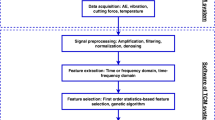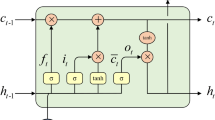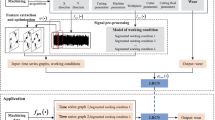Abstract
Predictive maintenance (PdM) has tremendous potential for reducing total operational costs and turnaround time in industrial manufacturing and maintenance services. In recent years, many deep learning based prediction methods have emerged and advanced the state-of-the-art in the PdM area. This paper proposes a holistic tool wear prediction framework that orchestrates convolutional neural networks for multisensor sequence learning, synthetic features to augment small training datasets, and a meticulously designed training regulation strategy. The effectiveness of the proposed framework is evaluated with computer numerical control (CNC) machine milling datasets available in the public domain. The results show that our method, sCNN-Ex, outperforms state-of-the-art tool wear prediction methods. sCNN-Ex reduces the prediction mean absolute percentage error from existing 32% to 21.7% for steel cases in the NASA milling dataset.





Similar content being viewed by others
Notes
RMSE and MAPE values in Table 2 are averages over all test cases by material.
References
Zonta T, Da Costa CA, da Rosa Righi R, de Lima MJ, da Trindade ES, Li GP (2020) Predictive maintenance in the industry 4.0: A systematic literature review. Comput Ind Eng 150:106889
Dalzochio J, Kunst R, Pignaton E, Binotto A, Sanyal S, Favilla J, Barbosa J (2020) Machine learning and reasoning for predictive maintenance in industry 4.0: Current status and challenges. Comput Ind 123:103298
Lei Y, Li N, Guo L, Li N, Yan T, Lin J (2018) Machinery health prognostics: A systematic review from data acquisition to rul prediction. Mech Syst Signal Process 104:799–834
Benkedjouh T, Medjaher K, Zerhouni N, Rechak S (2013) Remaining useful life estimation based on nonlinear feature reduction and support vector regression. Eng Appl Artif Intell 26(7):1751–1760
Wu D, Jennings C, Terpenny J, Gao RX, Kumara S (2017) A comparative study on machine learning algorithms for smart manufacturing: tool wear prediction using random forests. J Manuf Sci Eng 139(7)
Tobon-Mejia DA, Medjaher K, Zerhouni N (2012) Cnc machine tool’s wear diagnostic and prognostic by using dynamic bayesian networks. Mech Syst Signal Process 28:167–182
Nasir V, Sassani F (2021) A review on deep learning in machining and tool monitoring: methods, opportunities, and challenges. Int J Adv Manuf Technol 115(9):2683–2709
Wu J, Hu K, Cheng Y, Zhu H, Shao X, Wang Y (2020) Data-driven remaining useful life prediction via multiple sensor signals and deep long short-term memory neural network. ISA transactions 97:241–250
Yan D, Ding X, Pan S, Huang H (2021) Tool wear prediction based on edge data processing and deep learning model. In: Journal of Physics: Conference Series, vol 1820. IOP Publishing, p. 012165
Chen J, Chen D, Liu G (2021) Using temporal convolution network for remaining useful lifetime prediction. Eng Rep 3(3):12305
Ruiz-Tagle Palazuelos A, Droguett EL, Pascual R (2020) A novel deep capsule neural network for remaining useful life estimation. Proceedings of the Institution of Mechanical Engineers, Part O: Journal of Risk and Reliability. 234(1):151–167
Liu H, Liu Z, Jia W, Lin X, Zhang S (2020) A novel transformer-based neural network model for tool wear estimation. Meas Sci Technol 31(6):065106
Zhao R, Yan R, Wang J, Mao K (2017) Learning to monitor machine health with convolutional bi-directional lstm networks. Sensors 17(2):273
Malhotra P, Tv V, Ramakrishnan A, Anand G, Vig L, Agarwal P, Shroff G (2016) Multi-sensor prognostics using an unsupervised health index based on lstm encoder-decoder. 1st ACM SIGKDD Workshop on Machine Learning for Prognostics and Health Management
Zhang X, Qin Y, Yuen C, Jayasinghe L, Liu X (2020) Time-series regeneration with convolutional recurrent generative adversarial network for remaining useful life estimation. IEEE Trans Ind Inform 17(10):6820–6831
Zhao Z, Wu J, Li T, Sun C, Yan R, Chen X (2021) Challenges and opportunities of ai-enabled monitoring, diagnosis & prognosis: A review. Chinese Journal of Mechanical Engineering 34(1):1-29
Feng D, Haase-Schütz C, Rosenbaum L, Hertlein H, Glaeser C, Timm F, Wiesbeck W, Dietmayer K (2020) Deep multi-modal object detection and semantic segmentation for autonomous driving: Datasets, methods, and challenges. IEEE Trans Intell Transp Syst 22(3):1341–1360
Wager S, Wang S, Liang PS (2013) Dropout training as adaptive regularization. Advances in neural information processing systems, 26
Yu W, Kim IY, Mechefske C (2019) Remaining useful life estimation using a bidirectional recurrent neural network based autoencoder scheme. Mech Syst Signal Process 129:764-780
Xu W, Miao H, Zhao Z, Liu J, Sun C, Yan R (2021) Multi-scale convolutional gated recurrent unit networks for tool wear prediction in smart manufacturing. Chin J of Mech Eng 34(1):1–16
Borovykh A, Bohte S, Oosterlee CW (2018) Dilated convolutional neural networks for time series forecasting. Journal of Computational Finance, Forthcoming
Bai S, Kolter JZ, Koltun V (2018) Convolutional sequence modeling revisited. 6th International Conference on Learning Representations, ICLR 2018 Workshop
Duan Y, Li H, He M, Zhao D (2021) A bigru autoencoder remaining useful life prediction scheme with attention mechanism and skip connection. IEEE Sensors J 21(9):10905–10914
Kaur H, Pannu HS, Malhi AK (2019) A systematic review on imbalanced data challenges in machine learning: Applications and solutions. ACM Comput Surv (CSUR) 52(4):1–36
Delgado JMD, Oyedele L (2021) Deep learning with small datasets: using autoencoders to address limited datasets in construction management. Appl Soft Comput 112:107836
Chen RJ, Lu MY, Chen TY, Williamson DF, Mahmood F (2021) Synthetic data in machine learning for medicine and healthcare. Nat Biomed Eng 5(6):493–497
Yang Z, Chai Y, Anguelov D, Zhou Y, Sun P, Erhan D, Rafferty S, Kretzschmar H (2020) Surfelgan: Synthesizing realistic sensor data for autonomous driving. In: Proceedings of the IEEE/CVF Conference on Computer Vision and Pattern Recognition, pp 11118–11127
Shamsolmoali P, Zareapoor M, Granger E, Zhou H, Wang R, Celebi ME, Yang J (2021) Image synthesis with adversarial networks: A comprehensive survey and case studies. Information Fusion 72:126–146
Lu H, Barzegar V, Nemani VP, Hu C, Laflamme S, Zimmerman AT (2021) Gan-lstm predictor for failure prognostics of rolling element bearings. In: 2021 IEEE International Conference on Prognostics and Health Management (ICPHM), pp 1–8. IEEE
Zhu Q, Sun B, Zhou Y, Sun W, Xiang J (2021) Sample augmentation for intelligent milling tool wear condition monitoring using numerical simulation and generative adversarial network. IEEE Trans Instrum Meas 70:1–10
Martínez-Arellano G, Terrazas G, Ratchev S (2019) Tool wear classification using time series imaging and deep learning. Int J Adv Manuf Technol 104:3647–3662
Mirza M, Osindero S (2014) Conditional generative adversarial nets. arXiv preprint arXiv:1411.1784
Goodfellow I, Pouget-Abadie J, Mirza M, Xu B, Warde-Farley D, Ozair S, Courville A, Bengio Y (2020) Generative adversarial networks. Commun ACM 63(11):139–144
Moradi R, Berangi R, Minaei B (2020) A survey of regularization strategies for deep models. Artif Intell Rev 53(6):3947–3986
Orzech G (2020) Intelligent Systems Division. NASA. http://ti.arc.nasa.gov/project/prognostic-data-repository
2010 PHM Society Conference Data Challenge (2010). https://www.phmsociety.org/competition/phm/10
Funding
No funds or grants was received for conducting this study.
Author information
Authors and Affiliations
Corresponding author
Ethics declarations
Conflicts of interests
Yeli Feng is a principal research scientist with ST Engineering IHQ Pte. Ltd..
Competing interests
The authors have no competing interests to declare that are relevant to the content of this article.
Additional information
Publisher's Note
Springer Nature remains neutral with regard to jurisdictional claims in published maps and institutional affiliations.
Rights and permissions
Springer Nature or its licensor (e.g. a society or other partner) holds exclusive rights to this article under a publishing agreement with the author(s) or other rightsholder(s); author self-archiving of the accepted manuscript version of this article is solely governed by the terms of such publishing agreement and applicable law.
About this article
Cite this article
Feng, Y. A holistic approach for improving milling machine cutting tool wear prediction. Appl Intell 53, 30329–30342 (2023). https://doi.org/10.1007/s10489-023-04793-0
Accepted:
Published:
Issue Date:
DOI: https://doi.org/10.1007/s10489-023-04793-0




